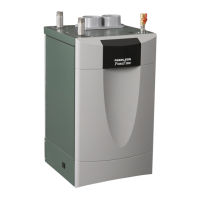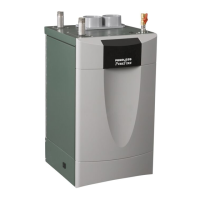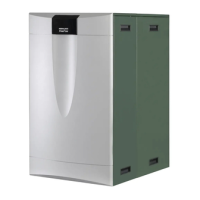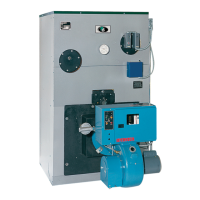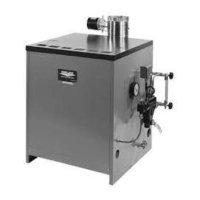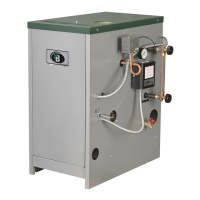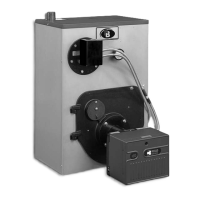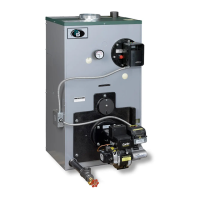How to fix supply sensor not connected error on PEERLESS PureFire PF-210 Boiler?
- LldavisSep 5, 2025
If your PEERLESS Boiler displays the error 'SUPPLY SENSOR NOT CONNECTED', check the harness and sensor.
How to fix supply sensor not connected error on PEERLESS PureFire PF-210 Boiler?
If your PEERLESS Boiler displays the error 'SUPPLY SENSOR NOT CONNECTED', check the harness and sensor.
How to troubleshoot ignition error on PEERLESS PureFire PF-210?
If you are experiencing an ignition error with your PEERLESS Boiler, follow these steps: 1. Watch the igniter through the observation window. 2. If no spark is present, check the spark electrode for the proper 3/16" gap. 3. Remove any corrosion from the spark electrode with abrasive. 4. If spark is present but no flame, check the gas supply to the boiler. Check for high or low pressure. 5. If there is a flame, check the flame signal ignition log in the Installer Menu. If values for flame signal are less than 3.1 µA, check wiring connections and clean the harness connector at the control. 6. Determine if gas valve is opening by monitoring gas pressure. 7. Check gas pressure.
What to do for false flame detected after shutdown on PEERLESS PureFire PF-210?
If your PEERLESS Boiler displays 'A19 - FALSE FLAME DETECTED AFTER SHUTDOWN', check the flame sensor and igniter to ensure there is no short to ground. This error may also indicate that the gas valve isn’t closing completely.
Why is the return higher than supply on my PEERLESS PureFire PF-210 Boiler?
If you see 'RETURN HIGHER THAN SUPPLY' on your PEERLESS Boiler, check the system piping to ensure water enters the return connection and exits the supply connection correctly. Also, compare the supply thermistor reading to the temperature gauge; if they don’t match, replace the supply thermistor.
How to fix poor ground error on PEERLESS PureFire PF-210 Boiler?
If your PEERLESS Boiler is showing 'POOR GROUND' error, check the boiler ground and harness.
What causes high stack temperature in PEERLESS PureFire PF-210 Boiler?
If your PEERLESS Boiler has a 'HIGH STACK TEMPERATURE', and the flue pipe is hot, check the flue temperature and compare it to the values in Table 8.5. Also, inspect for proper gas input and combustion readings, and check for a dirty heat exchanger. If the flue pipe is not hot, check the flue sensor and harness.
How to troubleshoot a blocked vent in PEERLESS Boiler?
If you have a blocked vent in your PEERLESS Boiler, check for a blocked vent pipe or blocked heat exchanger. Also, check the switch and tubing connected to the switch.
What to do if PEERLESS PureFire PF-210 showing false flame detected?
If your PEERLESS Boiler shows a 'FALSE FLAME DETECTED' error, first verify there is no flame in the observation port, then check the sensor.
How to fix hot/neutral reversed error on PEERLESS Boiler?
If your PEERLESS Boiler displays the error 'HOT/NEUTRAL REVERSED', verify the polarity of the incoming wiring and check the boiler ground and harness.
What to do if there is a false flame detected before ignition in my PEERLESS PureFire PF-210?
If you're experiencing a false flame detected before ignition with your PEERLESS Boiler, check the flame sensor and igniter to ensure there are no shorts to ground.
Follow installation instructions in order for a logical sequence.
Definitions for DANGER, WARNING, CAUTION, and NOTICE boxes.
Boiler assembly, inspection, storage, and contractor qualifications.
Installation must comply with state, local codes, and specific standards.
Minimum clearances for boiler installation and use on combustible floors.
Requirements for supplying combustion and ventilation air to the boiler.
Prepare sketches and review sections for installation layout considerations.
Install venting system per codes and approved materials.
Lists approved materials for vent pipes and adhesives.
Guidelines for locating vent and air intake piping for proper function.
Specifies pipe sizes for exhaust vents and air intakes based on boiler model.
Instructions for connecting and installing exhaust and air intake piping.
Procedure for drilling and tapping the vent pipe for combustion analysis.
Steps for safely removing an existing boiler from a common venting system.
Guidelines for sizing water supply/return piping and system preparation.
Boiler operating requirements including pressure and minimum flow rates.
Brief descriptions of key system components like gauges, air separators, and expansion tanks.
Information on using glycol solutions and freeze protection settings.
Fuel piping installation must comply with local codes and NFPA standards.
How to determine required gas flow rate and pipe capacity.
Instructions for installing gas supply piping, including sediment trap requirements.
Procedures for purging, checking gas pressure, and leak testing.
Instructions for adjusting and checking the main gas valve and CO2 settings.
Disposal of condensate according to local codes and proper piping.
Overview of the condensate trap system, collector, and float switch.
Approved materials for condensate piping, avoiding corrosive metals.
Guidelines for sizing condensate drain pipe and tubing.
Instructions for connecting condensate piping and using a condensate pump.
Wiring must comply with local codes and the National Electrical Code.
Diagrams for connecting thermostats, sensors, circulators, and voltage supply.
Wiring diagram for a typical circulator zone relay.
Schematic of boiler wiring and list of internal components.
Description of the boiler control, its safety features, and heating/DHW modes.
Graphical representation and detailed steps of the boiler's ignition cycle.
Information on installation location, vent material, freeze protection, and safety functions.
Detailed explanation of the 8 central heating modes available.
Overview and descriptions of the three domestic hot water modes.
How to view system status, sensor readings, and fault history.
Information on cascading boilers for increased capacity.
Initial checks before starting the boiler, including water, gas, and electricity.
Steps for filling and purging the system with water.
Verifying gas supply pressure and connections.
Verifying boiler operation, setpoints, and shutdown behavior.
Step-by-step instructions for lighting and operating the boiler safely.
How blocking errors are displayed and suggested corrective actions.
How locking errors are displayed and procedures for resetting.
Explains warning errors related to sensors and their corrective actions.
General observations and checks for the boiler during operation.
Annual inspection requirements for safety and performance.
Procedures for cleaning condensate tanks and hoses.
Steps for cleaning the heat exchanger coils for optimal combustion.
Table showing physical dimensions of various boiler models in inches.
Table listing input, output, heating capacity, and efficiency ratings.
Fan speed specifications for ignition, low, and high power modes.
Specifications for the boiler's main control unit and sensors.
Electrical ratings for blower, gas valve, pumps, and total service current.
List of general repair parts and their stock codes for specific boiler models.
Illustrated breakdown of heat exchanger and burner assembly parts.
Detailed list of heat exchanger and burner assembly repair parts.
Illustrated breakdown of general repair parts for PF-210 and PF-399 models.
List of general repair parts and stock codes for PF-210 and PF-399 models.
Illustrated breakdown of heat exchanger and burner assembly parts for PF-210 and PF-399.
Detailed list of heat exchanger and burner assembly repair parts for PF-210 and PF-399.
Displays boiler status like standby, CH/DHW trial for ignition, and demand.
Shows status for freeze protection, store warm hold, and other special functions.
Displays status for ignition failure, flame failure, and ignition retry.
Shows status for blocking errors and lockout errors, including reset instructions.
Displays current supply setpoint, system vent, outdoor temperature, and circulator status.
Allows adjustment of central heating, DHW, time/date, and temperature units.
Displays the last block and lockout messages.
Shows current supply setpoint, fan speeds, flame signal, ignition attempts, and run time.
Configuration options for pump mode, location, vent material, freeze protection, and safety functions.
Settings for CH modes, pump post purge, ramp delay, and max CH rate.
Settings for DHW modes, priority, heat dump, and max DHW rate.
Options to set up service reminders via time, cycles, or date.
Feature to force boiler operation for service and troubleshooting.
Configuration for multi-boiler cascade operation, including addressing and timing.
Options to restore factory or save/restore site default settings.
